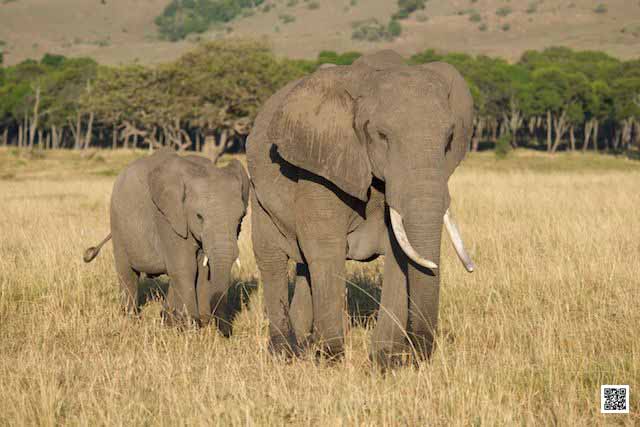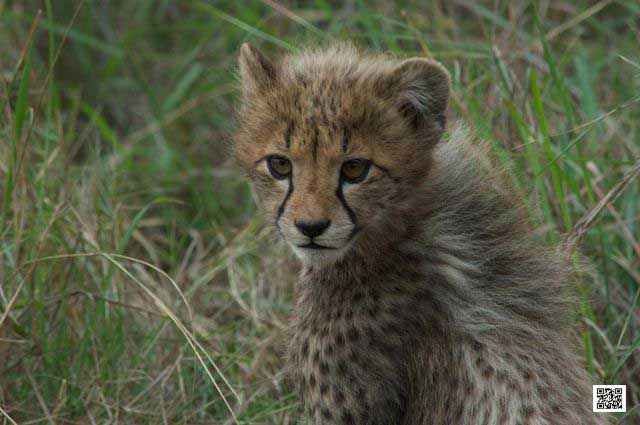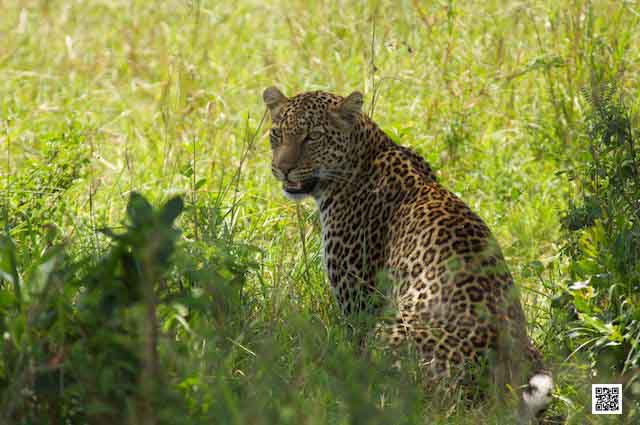28 April 2013
On Photo Safari: The Third Lion
04/05/13 16:27 Filed in: Photo Safari | Safari Story

Its such a thing with lion, when you see one, always wonder where are the others. That couldn’t have been more true than during a wildlife photography course we did a while ago in the Masai Mara in Kenya.
The wildlife photography course was part of a team building photographic safari and we had two open 4x4 jeeps to have enough space for photography. It was an afternoon game drive when we saw two mail lion lying in the grass on the open plains. It was an area where off road driving was allowed and we drove closer to the lion. All was fine. The male lion were beautiful, majestic lying in the grass with a bit of a distance between them and we drove from one to the other to see and photograph. While we were driving to the second lion we suddenly got stuck in the wet soft soil and all attempts to get out did not work. Fortunately we had two vehicles, so the other one came to pull us out, with the two male lion watching us. The drivers got out of the vehicle to connect the rope, carefully keeping an eye on the lion. The closest lion was about 60 meters away, but watching only relaxed what these creatures (us) were doing there. We all watched the two lion to make sure the guys on the ground were safe. Suddenly a third lion popped up, very close only about 20 meters away and he was annoyed. Most likely he had been sleeping and was now disturbed. He felt uncomfortable with us so close and we felt uncomfortable too, but our drivers managed to get the rope connected without problems and a moment later we were out and driving again.
The essence of this story is keep watching out when you are on photographic safari in a Big 5 area and be careful when you see a lion, there are most likely more and you don’t want to end up standing in the middle of a lion pride. Being in a vehicle is safe, but standing or walking on the ground is completely different. Then you are in their world.
Just keep that in mind when enjoying great lion sightings, don’t forget where you are.
Happy lion watching!
Ute Sonnenberg for www.rohoyachui.com
Photo Safari Destination Masai Mara
03/05/13 10:48 Filed in: Photographic safari destinations

The Masai Mara in Kenya is probably the most famous photographic safari, wildlife photography course and team building photographic safari destination in Africa. The Great Migration of the big herds of zebra, wildebeest and gazelle takes place from the end of July until the beginning of September (depending on the rain) and attracts visitors from around the world. There is hardly something more spectacular than the Mara River crossing of the big herds with many crocodiles waiting for them and a strong current that makes the crossing even more dangerous. Watching this is a breathtaking experience and a heaven for wildlife photographers.
But the Masai Mara is also without Great Migration a fantastic photographic safari destination. Throughout the year the wildlife sightings are amazing and there is always an abundance of wildlife. Besides that, the landscape is also stunning, the marsh with its characteristic beauty, the mountain range offering great views and the open plains, allowing wide views like looking over an ocean, dotted with animals .
The Masai Mara offers always beauty and great wildlife sightings, spectacular light and colors. It is a magnificent place to visit.
Here a practical tip. Outside the Great Migration period the accommodation rates drop and specials are available. That doesn’t mean it is not good to go there. The Masai Mara is always great, at any time of the year.
Got the taste? Try to go.
Ute Sonnenberg for www.rohoyachui.com
How Leadership Benefits from Intuition
02/05/13 18:38 Filed in: Intuition for Business

He saw things was said about Steve Jobs and probably similar attributes are used describing other charismatic innovative business leaders. What sets them apart from others?
The conscious use and trust in their intuition. Some of them might have had it always and never thought about it, reality had proved for them that they could rely on their intuition and they had never doubts. Others might have consciously learned it and went through a process of doubts and trust of falling and standing up. But the essence of all is that they were and are conscious of the benefits of utilizing their intuition for business decisions and strategies. There is nothing more reliable, nothing that leads to results faster and there is no better communication than the communication on intuitive level, completely independent from power supply and Internet access and more precise and resourceful than anything else. Tapping into the intuitive level means access to unlimited resources, only waiting to be used for the daily challenges of business and life.
Those who have doubts and would like to have a guided start into this medium can go on an intuition training photographic safari that works like a Silicon Valley Incubator. It can be a spin off to new dimensions in success and insight. And the guide is photography, a reliable tool, available anywhere at any time.
Ready for your intuition? Its waiting for you.
Ute Sonnenberg for www.rohoyachui.com
Henri Cartier-Bresson on Wildlife Photography?
01/05/13 15:32 Filed in: Wildlife Photography Courses

“For me photography was a mean of drawing and that’s all. Immediate sketch, done with intuition and you can’t correct it. If you have to correct it, it’s a next picture. “ (Henri Cartier-Bresson, The Decisive Moment)
Henri Cartier-Bresson is considered to be the father of modern photojournalism, yet photojournalism has a lot in common with wildlife photography. When you are on a photographic safari in the Masai Mara in Kenya with a wildlife photography course assignment photographing movement and you luckily come across a hunting lion, do you think you can ask the lion to do it again, because you are not happy with the photo? Of course not, the moment is gone, just like in photojournalism. Your next picture captures or draws a new moment and just be always ready for the moments that might come.
Wildlife photography done during team building photographic safaris shows even how an entire group of people can align during a few game drives to be in some kind of same flow of immediate sketches telling the story of a day of wildlife photography and at the same time the story of the people, the photographers.
The sketches are the photos and they show the subject and the photographer at that very moment, ready or not for the hunting lion or the man on the street making a certain gesture.
“Life is once, forever” (Henri Cartier-Bresson) also in wildlife photography.
Enjoy the moment.
Happy snapping!
Ute Sonnenberg for www.rohoyachui.com
How Wildlife Photography can Benefit from Ansel Adams
30/04/13 08:36 Filed in: Wildlife Photography Courses | Photography & Art

Outstanding contrast and clarity are attributes connected to Ansel Adam’s photography. It characterized his work from the very beginning, although at this time the “Pictoralism” method was popular. And isn’t it contrast that fascinates us in photography, literarily as light contrast and as “contrast subjects”?
Wildlife photography courses can use Ansel Adams’ work to teach seeing and photographing contrast in nature, even in a rock, like he did. On a photographic safari with wildlife photography course or team building photographic safari people often struggle to photograph “rock like” animals like rhinos and elephants. Their body shape and skin color make it not easy to get good photographs, photographs with contrast, depth and a well proportioned body. From Ansel Adams wildlife photographers can learn what angle to use and with which light to photograph to get a nice photograph. Only look at his pictures from Yosemite, the monolith or El Capitan (photograph below). He was a master in creating depth in something big and bulky with an even color.
By studying his work, wildlife photography can improve and rhinos, elephants and thought boring landscapes become fascinating mesmerizing photographs. Try it with simple things at home that resist to be photographed nicely and then take it to wildlife photography.
Learn and benefit from a master. Happy snapping!
Ute Sonnenberg for www.rohoyachui.com
How Wildlife Photographers can Learn from Diane Arbus
29/04/13 12:17 Filed in: Wildlife Photography Courses

Diane Arbus’ name is often associated with photographs of the strange and abnormal. And this approach of hers is the learning point for photographers in general and wildlife photographers in particular. Watch out for the “strange and abnormal”. For wildlife photography courses in the Masai Mara, photographic safaris and team building photographic safaris in South Africa and activities at all other safari destinations does that mean that you should train your eye in scanning the surroundings when driving on a game vehicle.
One often wonders how the ranger could see that animal in the tree or in the deep grass, but his/her eye is trained to see what is not supposed to be there, the strange and the abnormal. That can be a movement, a color or an object that breaks the pattern of the grass and well, the animal is spotted.
The same principle applies to wildlife photography (and any other photography). When you are on a game drive and you think the light is dull and there is nothing to see, start searching for the abnormal and strange. Your eye will adjust to this mode, which is comparable to the eye test one has to do at the eye doctor where you look at a picture with often dots in different colors and by changing the way you look at it you see different objects in it. Do the same when you look out over the Great Plains of the Masai Mara and start seeing things like contrast in grass going over in different colors of the horizon or patterns on the road or in the clouds and animals you did not notice before.
Try it and by looking out for the abnormal you will suddenly find wonderful subjects for your photography, even when you think there is nothing.
Happy watching!
Ute Sonnenberg for www.rohoyachui.com
ePhoto Book: Grace
28/04/13 00:43 Filed in: Photography & Art

The Atlantic coast in France is rough, beautiful and elegant. Deauville is the favorite weekend escape of the le chic of Paris. They enjoy relaxing at the beach, shopping in the exclusive stores and the horse races with lots of money involved.
Get a glimpse of this world so different from photographic safaris, or well it is a photographic experience of its own.
Enjoy Grace.
Ute Sonnenberg for www.rohoyachui.com